Template Only Features (OnePager Pro)
Contents
Caution on Templates (OnePager Pro)
Because the “Template Properties” and “Project-View Properties” forms are similar, this article only covers the areas of the former that are different from the later. If you are unclear on the difference between a template and a project view, please review the explanation in the Core Concepts (Portal) article.
You should familiarize yourself with “Project-View Properties” form before reading this section.
A Few Words On Templates
The template was discussed in the Core Concepts (Portal) article. However there are a couple of things about templates that need to be covered here.
- a) Permanent Template: Chronicle Graphics, Inc. ships OnePager Pro one pre-defined permanent templates that you cannot accidentally delete. The permanent template has the word “Permanent” in its name. The permanent template cannot be modified hence all the control features on each tab are disabled (ghosted).
- b) Simple and Detailed: Templates with the word “Simple” in the title denote templates that are designed to focus on summary information from a Microsoft Project plan. “Detailed” templates are designed to support information at a task/milestone level with considerable fidelity. The differences are subtle.
- c) Metric versus Non-Metric: Within a template there are settings which are measures that must be considered when building the project view graph. These include the height of individual rows, the height of the percent-complete bar within a task bar, and the like. OnePager supports two measurement conventions: English (inches) and Metric (centimeters). For convenience you can identify a “Metric” based template because the word “(metric)” is included in the title. And these two sets of templates are separated by default into an English and a Metric subfolder of the default Templates folder.
Main Template Tab
The “Main” tab of the “Template Properties” form differs slightly from the “Project-View Properties” form. The template does not have entry positions for the Start date, and End date, or project view title, because these are project-specific fields, and the template is meant to be the starting point for many project views that summarize many projects.
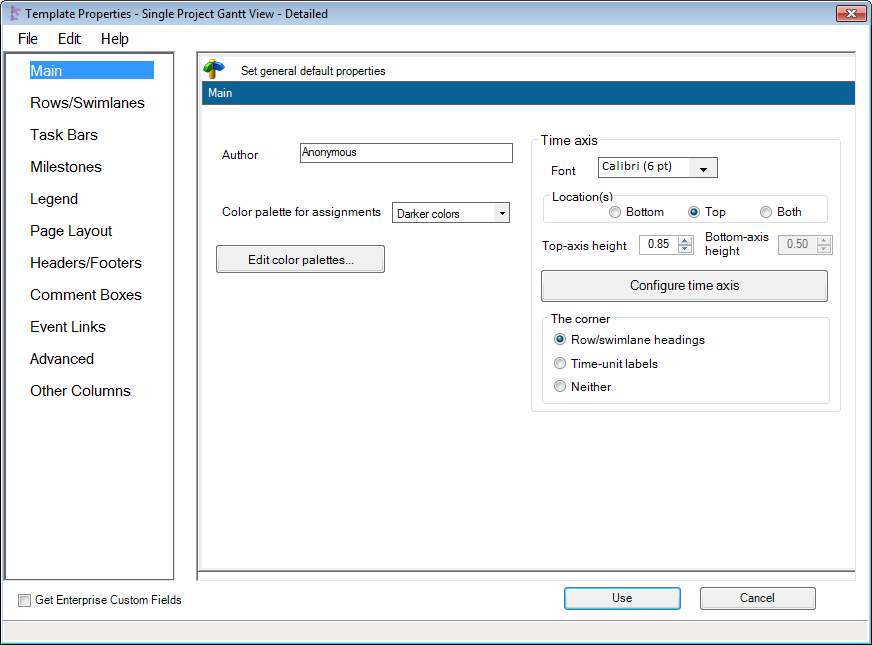
Advanced Template Tab
The “Advanced” tab is shown below. Most of these parameters in the template are identical to those appearing in the “Project-View Properties” form.
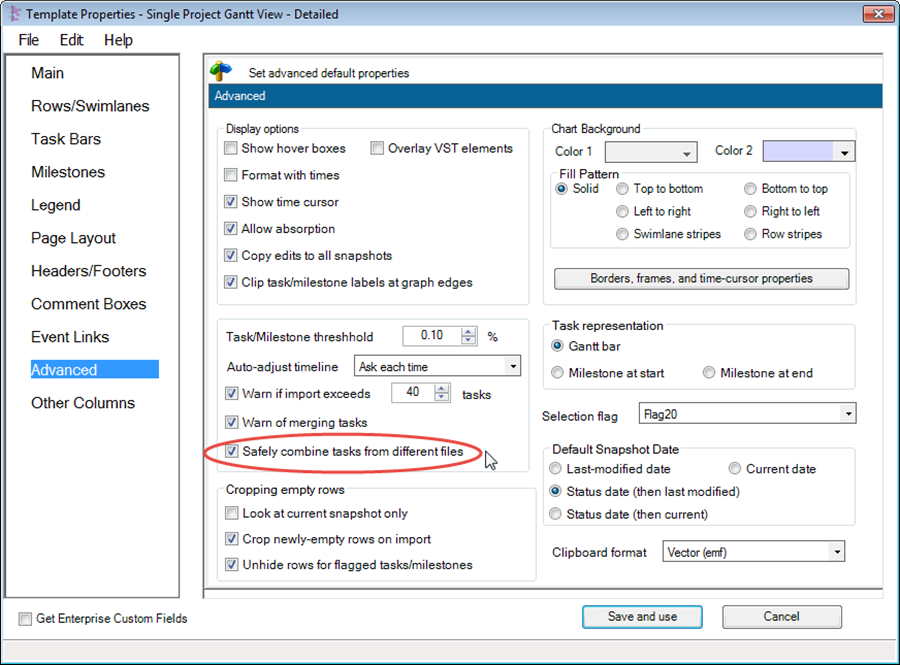
- a) In the template’s “Advanced” tab there is no “Lock background” checkbox in the Display options section. This is an option available after the project view is created.
- b) One key difference between the “Template Properties” form and “Project-View Properties” form is the ability to use the template to configure a multi-project import without the use of some sort of Microsoft Project integrated master schedule.
Safely combine tasks from different files
Checking this box in the template puts any project views created with this template into the “Multi-File Multi-Project Mode”. This mode is specifically designed to support users who want to create multi-project project views from independent Microsoft Project plans without creating a Microsoft Project integrated master schedule (IMS) prior to creating the project view. This is an advanced feature and when used, OnePager will number tasks and milestones imported from the various Microsoft Project plans accessed differently than when only a SINGLE project plan is imported by OnePager. This is done so that OnePager can establish a means to support your creation of subsequent snapshots for the multi-file multi-project project view in the future. Once you have adopted this scheme for the project view being created, it is not possible to update the project view in the future in the default single-file single-project mode. To enforce this requirement the OnePager Pro’s “Project-View Properties” “Advance” tab shows the “Safely combine tasks from different files” check box but the command is ghosted.
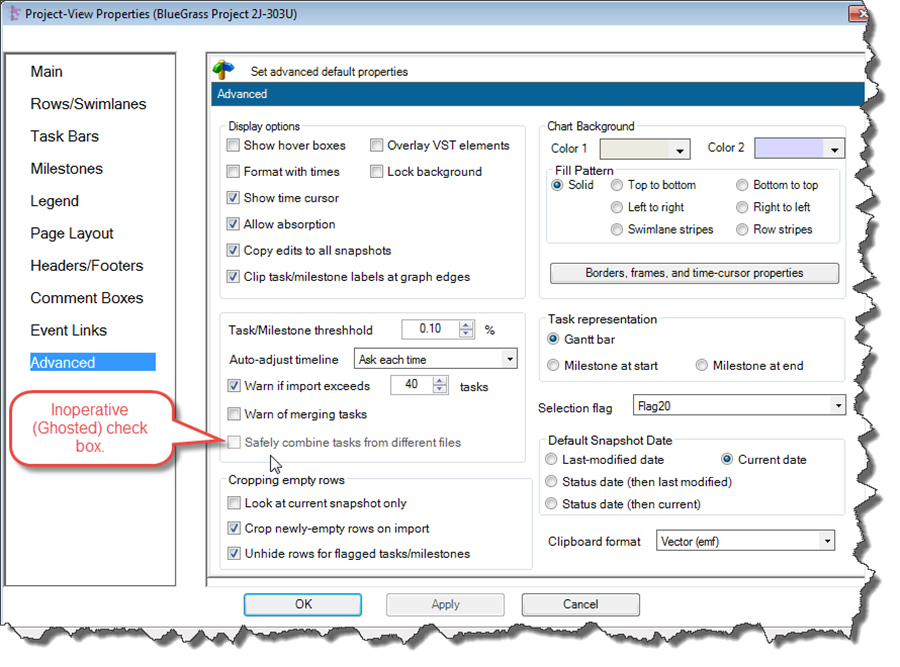
Other Columns Tab
This tab is unique to the template, and is not available in “Project-View Properties” form. The “Other Columns” tab is shown below:
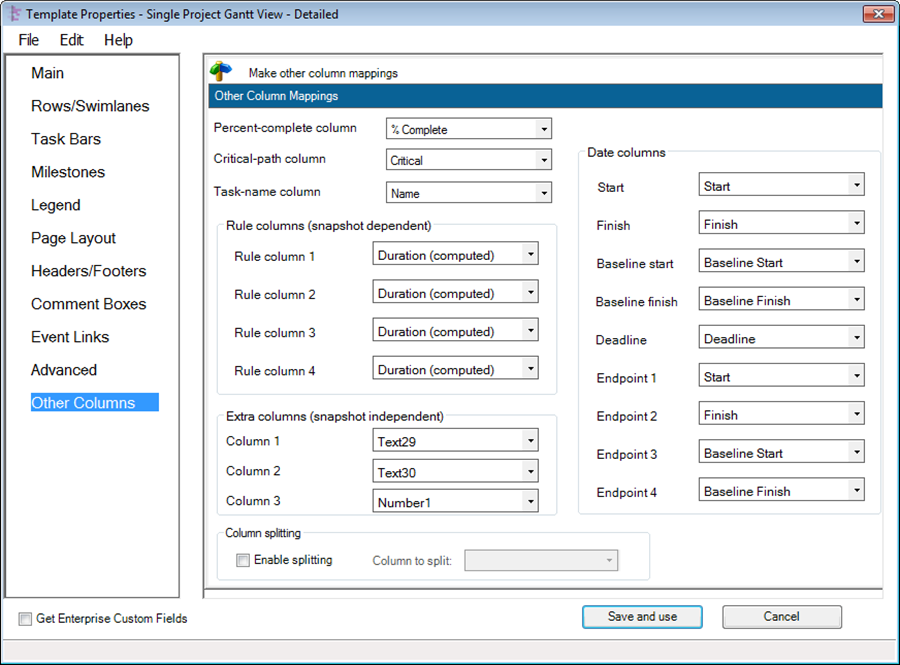
- a) This tab allows you to specify which columns, including additional columns from your Microsoft Project plan, should be imported when the project view is first created. This tab gives you the flexibility to use columns for conditional formatting, row labelling, or round-robin color that you did not use when you originally created the project view.
- b) As shown in the “Other Columns” tab form above, there are window options available for you to change the columns used for the “Percent-complete column”, the “Critical-path column”, and the “Task-name column.” These are useful in the template whenever your standard for using Microsoft Project is different than the common columns used for these data elements.
- c) Additionally, you may change the “standard” Microsoft Project plan usage for any of the columns mentioned in the “Date columns” group shown on the right side of the “Other Columns”. This is useful is your “standard” column usage differs and you want to avoid having to constantly make the changes on the second page of “OnePager choices” form shown below:
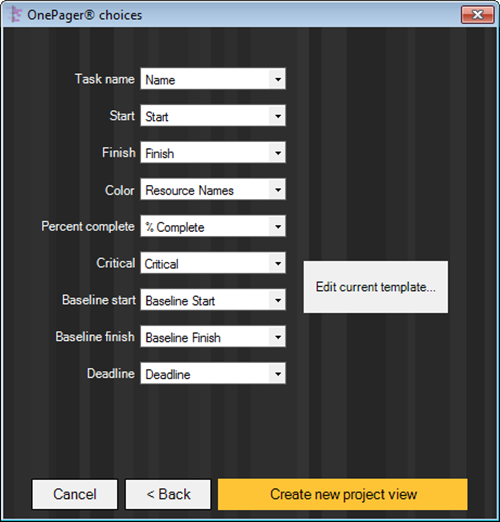
Rules Column (snapshot dependent) group
When you desire to make use of additional Microsoft Project plan columns for the creation of Conditional Formatting rules, it is necessary to mention these columns in this Template tab before creating your project view.
- a) These four (4) columns, with their associated window drop downs, are available for use with Conditional Formatting Rules.
- b) However, these four (4) columns are not exclusively reserved for this purpose so you may use them for whatever creative purpose you have in mind.
Extra Columns (snapshot independent) group
The “Other Columns” tab also lets you import three extra columns from your Microsoft Project plan in case you later change your mind about which Microsoft Project plan columns you want to use.
- a) These three (3) extra columns as with the four (4) “Rule” columns mentioned above may be used for any purpose such as providing the data for row or swimlane labels, round-robin color assignments, collecting tasks into rows, ordering rows and swimlanes in the project view, and automatically titling the Legend.
- b) To say the least, using these features requires some forethought and advanced planning on your part. These features are powerful and give you a great deal of flexibility when making project views for schedule conversations.
A Note
Note that only those Microsoft Project plan columns specified on this tab of the “Template” form, on the “Rows and Swimlanes” tab, and on the “Task Bars” and “Milestones” tabs (e.g. the round-robin color column and conditional formatting columns) will be imported to OnePager and are available to you once the project view is created.
The features described here are not available on the “Project-View Properties” form as that form is available after data are imported from your Microsoft Project plan.
(24.1)